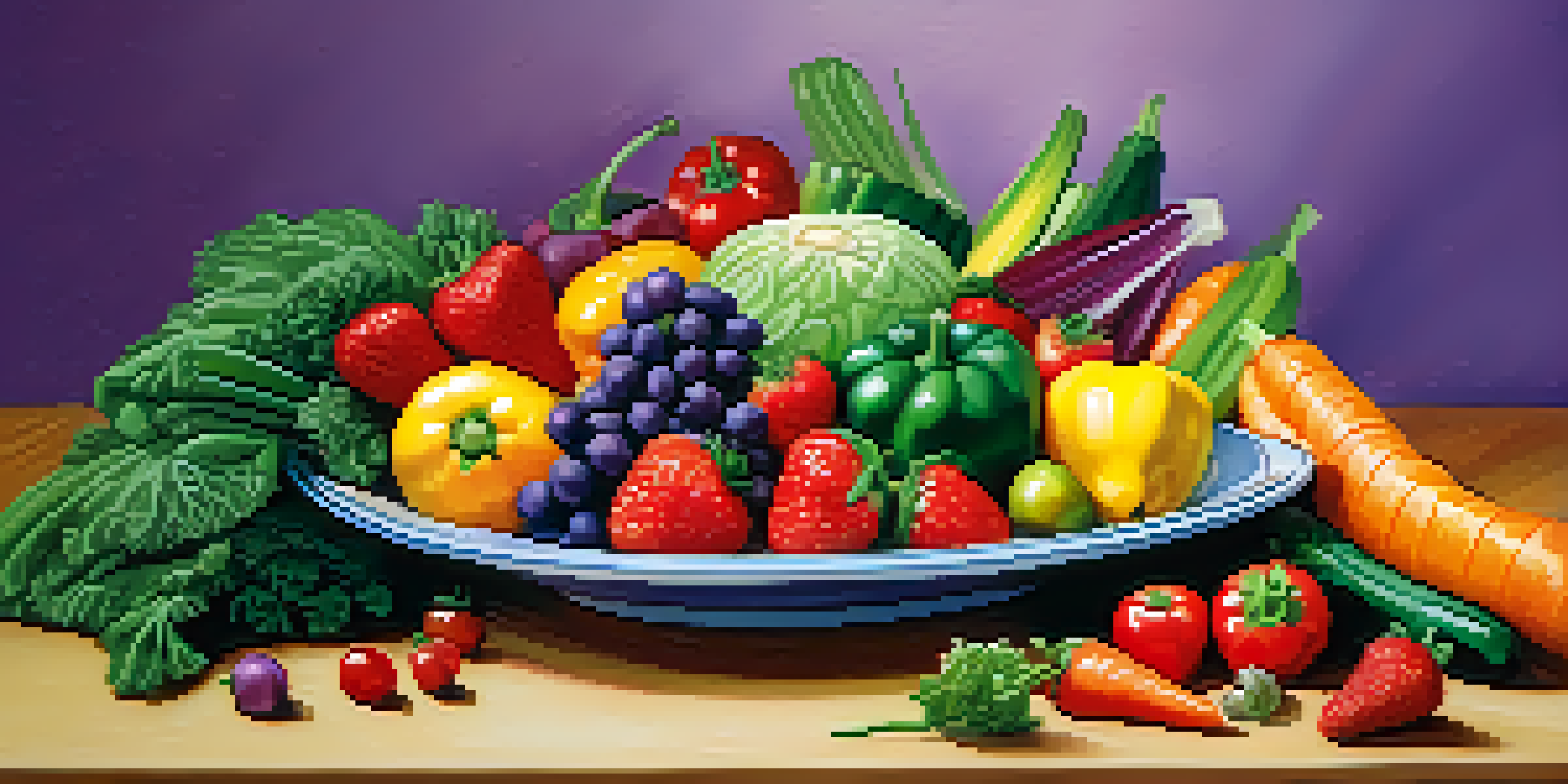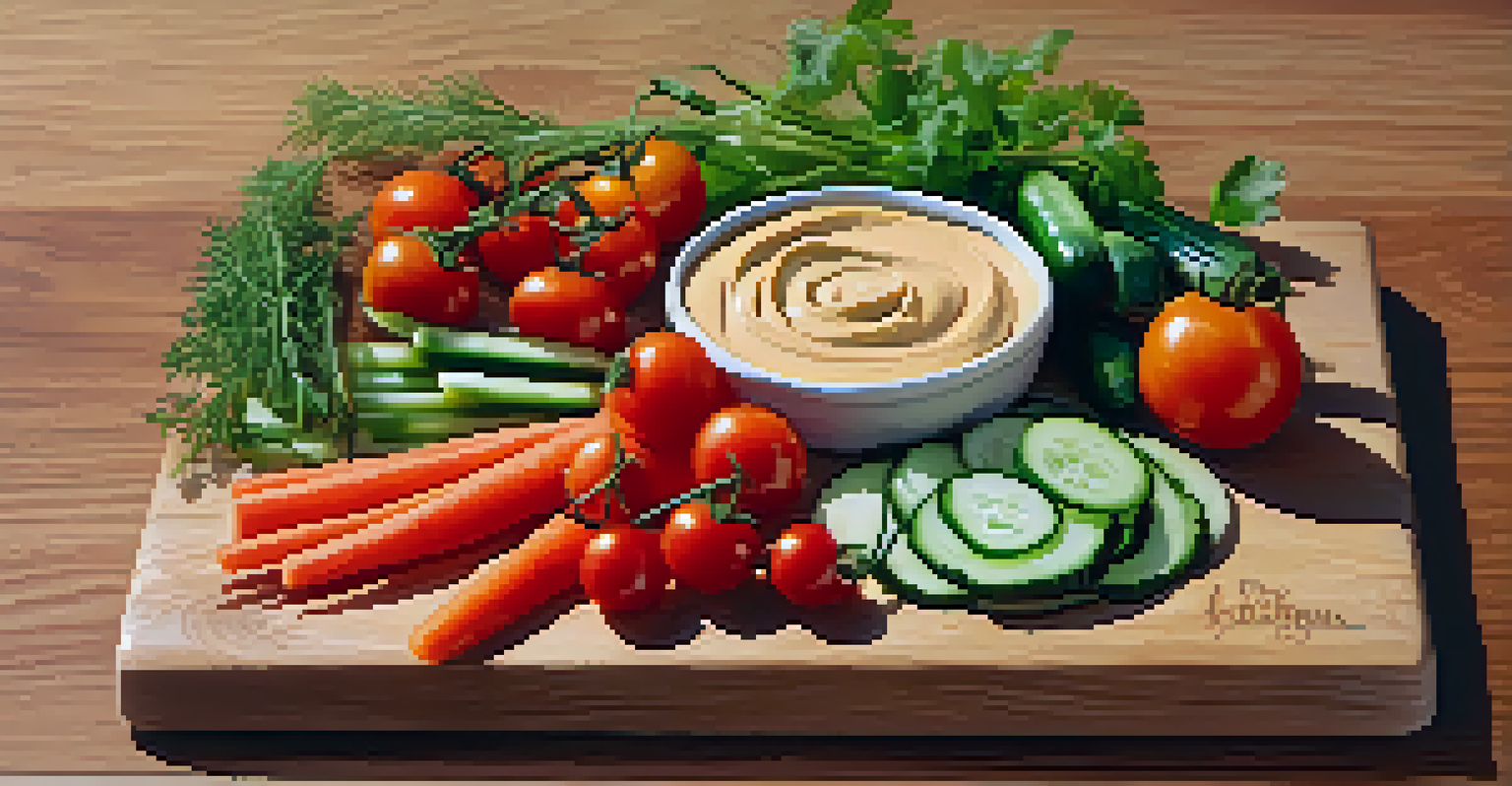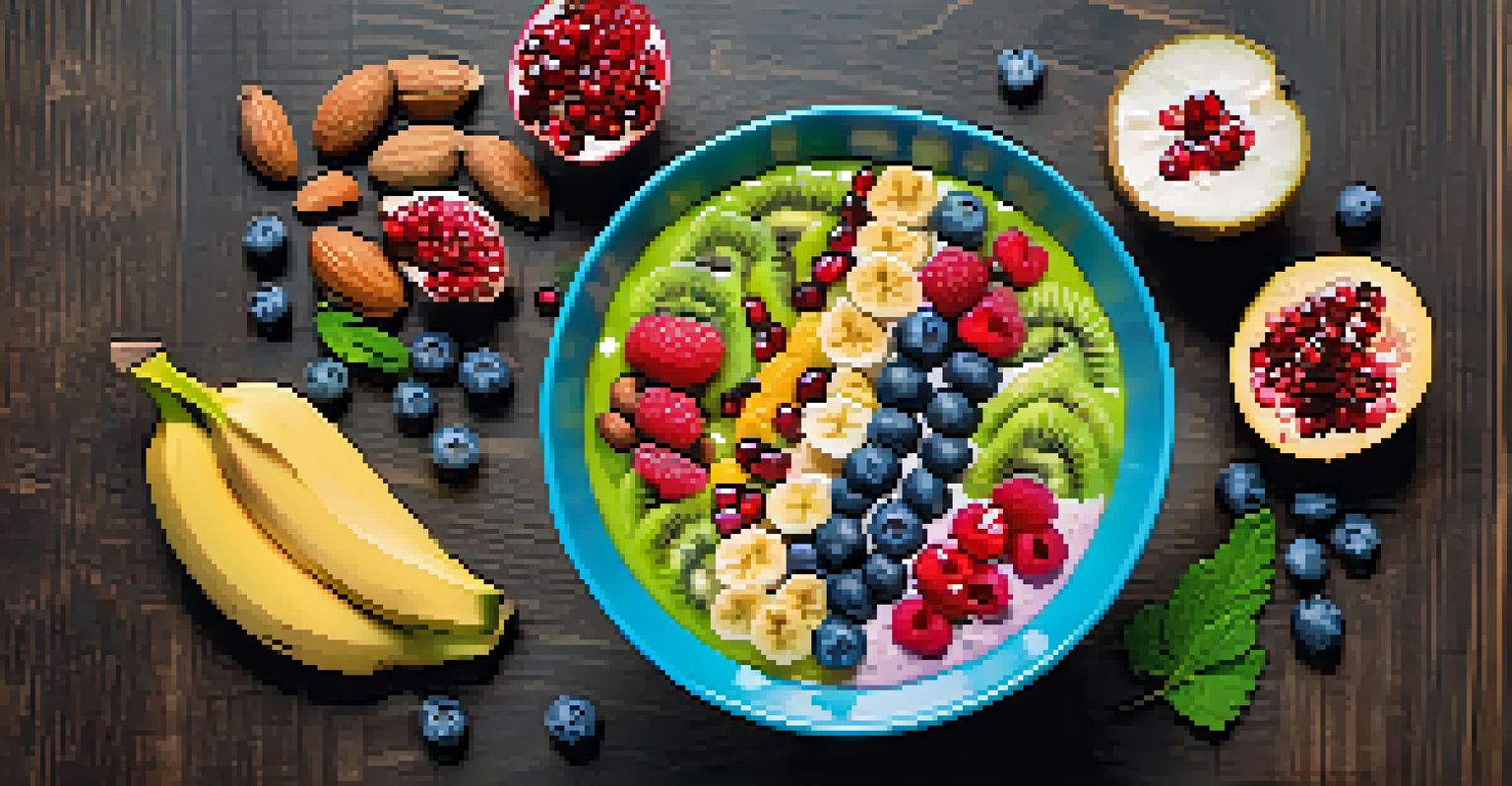Colorful Raw Foods: How Variety Boosts Nutritional Intake

The Importance of Color in Your Diet
When it comes to nutrition, the colors of the foods you eat can tell you a lot about their health benefits. Different colors often indicate the presence of various vitamins, minerals, and antioxidants. For instance, orange and yellow fruits like oranges and mangoes are rich in vitamin C, while leafy greens like spinach pack a punch of iron and calcium. By incorporating a variety of colors into your meals, you ensure a broad spectrum of nutrients.
Let food be thy medicine and medicine be thy food.
Think of your plate as a canvas; the more colors you add, the more vibrant—and nutritious—it becomes. Each hue brings unique benefits that contribute to overall health. For example, red foods such as tomatoes and strawberries are loaded with lycopene, a powerful antioxidant that supports heart health. By eating a rainbow, you're not just making your meals appealing to the eye; you're also safeguarding your well-being.
Variety is not only essential for nutrition but also for keeping your meals exciting. Eating the same foods can lead to boredom, making it harder to maintain healthy eating habits. By choosing colorful raw foods, you can experiment with different flavors and textures that keep your taste buds happy while boosting your health.
Nutritional Benefits of Raw Foods
Raw foods, particularly fruits and vegetables, are packed with vitamins, minerals, and enzymes that can be diminished through cooking. For example, cooking can reduce the vitamin C content in broccoli by up to 50%. This means that by consuming raw broccoli, you’re maximizing its nutritional potential. Including raw foods in your diet often leads to higher energy levels and better digestion, thanks to the natural enzymes present in these foods.

In addition to retaining nutrients, raw foods are often lower in calories and higher in fiber. This balance helps you feel full longer, which can aid in weight management. Foods like carrots and bell peppers are not only crunchy and delicious but also help keep your digestive system running smoothly. The fiber content found in raw foods can also lower cholesterol levels and improve heart health.
Eat the Rainbow for Health Benefits
Incorporating a variety of colorful foods ensures you receive a broad spectrum of essential nutrients.
Moreover, raw foods can enhance your hydration levels, as many fruits and vegetables have high water content. Cucumbers, for instance, are about 95% water, making them an excellent snack on a hot day. This increased hydration can lead to clearer skin and improved overall health. So, opting for raw foods is an easy way to stay refreshed while reaping numerous health benefits.
Building a Colorful Raw Food Plate
Creating a colorful raw food plate is all about balance and creativity. Start by choosing a variety of fruits and vegetables that span the color spectrum. For example, you might include red strawberries, orange carrots, yellow bell peppers, green cucumbers, and purple cabbage. Each of these options not only adds visual appeal but also contributes unique nutrients.
Eating colorful foods is not just about aesthetics; it's about nourishing your body and mind.
Incorporating nuts and seeds can also enhance the nutritional value of your plate. For instance, adding almonds can provide healthy fats and protein, while chia seeds offer omega-3 fatty acids. You can even mix in some dried fruits for a sweet touch, ensuring that your plate is not only healthy but also delicious. This variety will keep you satisfied and eager to explore new combinations.
Don’t be afraid to experiment with different textures and flavors. You could create a vibrant salad, a colorful smoothie bowl, or even a raw veggie platter with hummus. The key is to make it fun and appealing, encouraging you to eat more of these nutritious foods. Remember, the more colorful your plate, the more nutrients you are likely to consume!
How Variety Affects Nutritional Absorption
Eating a variety of colorful raw foods can significantly enhance your body’s ability to absorb nutrients. When different nutrients work together, they can improve overall absorption rates. For example, consuming vitamin C-rich foods alongside iron-rich foods can enhance iron absorption. This is why pairing raw bell peppers with spinach in a salad is not just visually appealing but also beneficial for your health.
Additionally, diverse food sources can help your gut microbiome thrive. A healthy gut is crucial for nutrient absorption and overall health. Different foods can provide various types of dietary fiber, which feed different strains of beneficial gut bacteria. By incorporating a range of colorful raw foods, you create an optimal environment for your gut to flourish.
Raw Foods Enhance Nutritional Value
Consuming raw fruits and vegetables maximizes their vitamin content and supports better digestion.
This enhanced absorption means that you’re getting more bang for your buck when it comes to nutrition. Instead of focusing solely on individual nutrients, think of your meals as a synergy of flavors and benefits. The more varied and colorful your diet, the better your body can utilize all the good stuff you’re consuming.
Practical Tips for Incorporating Colorful Raw Foods
Incorporating colorful raw foods into your diet doesn’t have to be complicated. Start by making small changes, like adding a serving of fruit or a handful of raw veggies to your meals. You can also keep washed and cut colorful snacks ready to grab. Carrot sticks, cherry tomatoes, and apple slices can make healthy snacking easy and enjoyable.
Another great tip is to explore your local farmer’s market or grocery store's produce section. Look for seasonal fruits and vegetables, as they are often more flavorful and nutrient-dense. Don’t hesitate to try new items you’ve never tasted before. Who knows, you might discover a new favorite! Keep your meals fresh and exciting by rotating the fruits and veggies you purchase each week.
Lastly, consider involving family or friends in your colorful raw food journey. Cooking and preparing meals together can make the process more enjoyable and encourage everyone to try new foods. By sharing recipes and ideas, you promote a healthy lifestyle in a fun and engaging way.
The Connection Between Color and Mental Well-Being
Interestingly, the colors of the foods we eat can also influence our mood and mental well-being. Brightly colored foods are often associated with freshness and vitality, which can evoke positive emotions. Research suggests that consuming a variety of colorful foods may help reduce feelings of anxiety and depression, promoting an overall sense of happiness.
Additionally, the act of preparing and eating colorful meals can be a joyful experience. The vibrant hues can stimulate your appetite and make eating feel like a celebration. Engaging with your food by experimenting with colors and flavors can encourage mindfulness, helping you appreciate the moment and the nourishment you’re providing your body.
Colorful Foods Boost Mental Well-Being
Brightly colored foods can improve mood and promote a more positive relationship with eating.
Incorporating colorful raw foods may lead to a more positive relationship with food. Instead of viewing meals solely as fuel, you can learn to enjoy the aesthetic and sensory experience of eating. This shift in perspective can promote healthier eating habits and a more balanced lifestyle.
Conclusion: Embrace the Rainbow for Better Health
In conclusion, embracing a colorful array of raw foods can significantly enhance your nutritional intake while making meals visually appealing. By consuming a variety of colors, you not only enjoy a broader range of nutrients but also improve your overall health and well-being. The simple act of adding more colors to your plate can lead to numerous benefits, including better digestion, enhanced mood, and improved nutrient absorption.
As you start incorporating more colorful raw foods into your diet, remember to keep it enjoyable and creative. Experiment with different combinations, textures, and flavors to keep your meals exciting. In doing so, you’ll find that healthy eating becomes a delightful journey rather than a chore.

So, why not start today? Head to your kitchen or local market, and let the colors inspire you to create vibrant, nutritious meals that nourish both your body and mind. After all, a rainbow on your plate is a step toward a healthier, happier you.